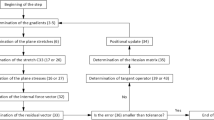Abstract
The crack tip stress fields for plate bending and membrane loading problems are reviewed and the four stress intensity factors that determine these fields are defined. These four stress intensity factors arise from use of Kirchhoff plate theory to account for the bending loads and two dimensional plane stress elasticity to account for the membrane loads. The energy release rate is related to the stress intensity factors and to the stress resultants of plate theory. Virtual crack extension, nodal release and modified crack closure integral methods are discussed for computing components of the energy release rate from finite element analyses of cracked plates. Sample computations of stress intensity factors for single and mixed mode cases are presented for a crack in an infinite plate. Sample computations of stress intensity factors for a double edge notched tension-torsion test specimen are given as well.
Similar content being viewed by others
References
R.S. Alwar and K.N. Ramachandran, Engineering Fracture Mechanics 17 (1983) 323–333.
E. Reissner, Quarterly of Applied Mathematics 5 (1947) 55–68.
J.G. Simmonds and J. Duva, Journal of Applied Mechanics 48 (1981) 320–326.
G.C. Sih, P.C. Paris and F. Erdogan, Journal of Applied Mechanics 29 (1962) 306–312.
Y. Murakami, Stress Intensity Factors Handbook-Vol. 2, Pergamon Press, Elmsford, New York (1987).
M.H. Aliabadi and D.P. Rooke, Numerical Fracture Mechanics, Kluwer Academic Publishers, Dordrecht (1991).
G.R. Irwin, Journal of Applied Mechanics 24 (1957) 361–364.
J.R. Rice, in Fracture, Vol. 2, H. Liebowitz (ed.) Academic Press (1968).
A.C. Ugural, Stresses in Plates and Shells, McGraw-Hill, New York (1981).
M.L. Williams, Journal of Applied Mechanics 24 (1957) 109–114.
M.L. Williams, Journal of Applied Mechanics 28 (1961) 78–82.
C.-Y. Hui and A.T. Zehnder, International Journal of Fracture 61 (1993) 211–229.
A.T. Zehnder, M.J. Viz and A.I. Ingraffea, in Proceedings of the VII International Congress on Experimental Mechanics, Society for Experimental Mechanics, Bethel, Connecticut (1992) 44–50.
D.M. Parks, International Journal of Fracture Mechanics 10 (1974) 487–502.
T.K. Hellen, International Journal of Numerical Methods in Engineering 9 (1975) 187–207.
H.G.de Lorenzi, Engineering Fracture Mechanics 21 (1985) 129–143.
T.K. Hellen and W.S. Blackburn, Engineering Computation 4 (1987) 2–14.
E. Riks, C.C. Rankin and F.A. Brogan, Engineering Fracture Mechanics 43 (1992) 529–548.
E. Riks, F.A. Brogan and C.C. Rankin, in Analytical and Computational Models of Shells, ASME-CED Vol. 3, A.K. Noor, T. Belytschko, and J.C. Simo (eds.) American Society of Mechanical Engineers, New York (1989) 483–507.
H. Ansell, Ph.D. thesis no. 138, Institute of Technology, Department of Mechanical Engineering, S-581 Linköping, Sweden, report no. LIU-TEK-LIC-1988:11 (1988).
D.O. Potyondy, Ph.D. thesis, School of Civil and Environmental Engineering, Cornell University (1993).
E.F. Rybicki and M.F. Kanninen, Engineering Fracture Mechanics 9 (1971) 931–938.
S. Viswanath, H.V. Lakshminarayana and D.D. Ravindranath, International Journal of Fracture 41 (1989) R45-R50.
A.T. Zehnder and C.-Y. Hui, Journal of Applied Mechanics 6 (1994) 719–722.
B.O. Almroth, F.A. Brogan and G.M. Stanley, ‘Structural Analysis of General Shells,’ User Instructions for STAGSC-1, Vol. 2, Report No. LMSC D633873, Lockheed Missiles and Space Co., Palo Alto, California (1986).
C.C. Rankin and F.A. Brogan, The Computational Structural Mechanics Testbed Structural Element Processor ES5: STAGS Shell Element, NASA CR-4358, Lockheed Missiles and Space Co., Palo Alto, California (1991).
M.J. Viz, A.T. Zehnder and J.-D. Bamford, Fracture Mechanics: 26th Volume, ASTM STP 1256, W.G. Reuter, J.H. Underwood, and J.C. Newman, Jr. (eds.) Philadelphia, Pennsylvania (1995).
Author information
Authors and Affiliations
Additional information
School of Civil and Environmental Engineering, Cornell University
Rights and permissions
About this article
Cite this article
Viz, M.J., Potyondy, D.O., Zehnder, A.T. et al. Computation of membrane and bending stress intensity factors for thin, cracked plates. Int J Fract 72, 21–38 (1995). https://doi.org/10.1007/BF00036927
Received:
Accepted:
Published:
Issue Date:
DOI: https://doi.org/10.1007/BF00036927




